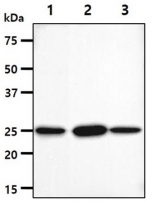ARG56996
anti-NQO2 antibody [7G7]
anti-NQO2 antibody [7G7] for Western blot and Human,Mouse
Overview
| Product Description | Mouse Monoclonal antibody [7G7] recognizes NQO2 |
|---|---|
| Tested Reactivity | Hu, Ms |
| Tested Application | WB |
| Host | Mouse |
| Clonality | Monoclonal |
| Clone | 7G7 |
| Isotype | IgG1, kappa |
| Target Name | NQO2 |
| Antigen Species | Human |
| Immunogen | Recombinant fragment around aa. 1-231 of Human NQO2. |
| Conjugation | Un-conjugated |
| Alternate Names | NRH dehydrogenase [quinone] 2; NMOR2; DHQV; Quinone reductase 2; NRH:quinone oxidoreductase 2; QR2; Ribosyldihydronicotinamide dehydrogenase [quinone]; DIA6; EC 1.10.5.1 |
Application Instructions
| Application Suggestion |
|
||||
|---|---|---|---|---|---|
| Application Note | * The dilutions indicate recommended starting dilutions and the optimal dilutions or concentrations should be determined by the scientist. |
Properties
| Form | Liquid |
|---|---|
| Purification | Purification with Protein G. |
| Buffer | PBS (pH 7.4), 0.02% Sodium azide and 10% Glycerol. |
| Preservative | 0.02% Sodium azide |
| Stabilizer | 10% Glycerol |
| Concentration | 1 mg/ml |
| Storage Instruction | For continuous use, store undiluted antibody at 2-8°C for up to a week. For long-term storage, aliquot and store at -20°C. Storage in frost free freezers is not recommended. Avoid repeated freeze/thaw cycles. Suggest spin the vial prior to opening. The antibody solution should be gently mixed before use. |
| Note | For laboratory research only, not for drug, diagnostic or other use. |
Bioinformation
| Database Links |
Swiss-port # P16083 Human Ribosyldihydronicotinamide dehydrogenase [quinone] Swiss-port # Q9JI75 Mouse Ribosyldihydronicotinamide dehydrogenase [quinone] |
|---|---|
| Gene Symbol | NQO2 |
| Gene Full Name | NAD(P)H dehydrogenase, quinone 2 |
| Background | This gene encodes a member of the thioredoxin family of enzymes. It is a cytosolic and ubiquitously expressed flavoprotein that catalyzes the two-electron reduction of quinone substrates and uses dihydronicotinamide riboside as a reducing coenzyme. Mutations in this gene have been associated with neurodegenerative diseases and several cancers. Alternative splicing results in multiple transcript variants. [provided by RefSeq, Mar 2014] |
| Function | The enzyme apparently serves as a quinone reductase in connection with conjugation reactions of hydroquinones involved in detoxification pathways as well as in biosynthetic processes such as the vitamin K-dependent gamma-carboxylation of glutamate residues in prothrombin synthesis. [UniProt] |
| Calculated MW | 26 kDa |
Images (1) Click the Picture to Zoom In






